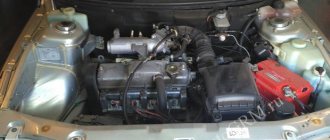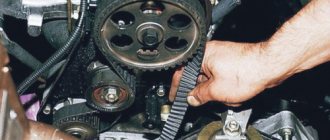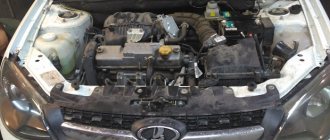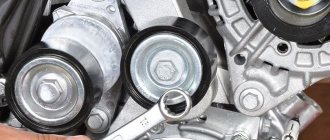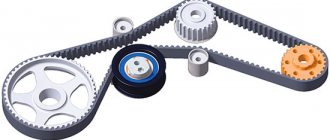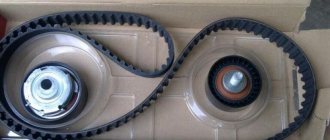Print this article Font size 16
The VAZ 2110 car is in serious demand among domestic buyers. This is a fairly reliable, moderately powerful product from the AvtoVAZ concern.
Belt faults
Malfunctions of the timing belt can arise as a result of its long-term operation, and can also be the result of incorrect adjustment or malfunctions of the pump or tension roller. These include:
- violation of the integrity of the belt (cracks, delamination);
- deformation;
- belt break.
If any of the specified malfunctions are detected, the belt must be replaced.
Signs of wear
The timing belt drive synchronizes the operation of the power unit. This is a very important function. The gas distribution mechanism ensures that the camshaft rotates at a speed lower than the crankshaft. And the main purpose of the timing belt is to release gases through the valves. But when the belt definitely needs to be replaced:
- the belt teeth are worn out;
- the structure has delaminated;
- the ends are torn;
- We have already talked about the presence of oil on the surface.
Why change the belt?
In accordance with the list of routine maintenance for the VAZ 2110, the timing belt must be changed after every 60-75 thousand kilometers, however, here you also need to take into account the conditions of its operation, and this is:
- temperature changes;
- oil getting on the belt;
- problems with the tension roller;
- faulty pump.
All this will inevitably lead to damage.
It is necessary to inspect at least once a month:
- belt (determining its integrity);
- tension roller ;
- water pump gear.
And although on 8-valve VAZ engines, the valve does not bend when the belt breaks, this breakdown can damage the pump or generator.
Proper belt tension and adjustment
You should pay attention to such a parameter as the tension of the generator belt. The operation of the generator is directly related to the operation of the crankshaft, so the belt drive must be in full working order. The belt tension should be optimal, in this case you don’t have to worry about the operation of the fuel system. Belt adjustment in the VAZ 2110 model is very important. Connect two pulleys whose rotation speed reaches several thousand revolutions per minute. In this case, the belt must be in sufficient contact with the pulley head, which eliminates the possibility of slipping. Three voltage options are possible:
- inadequate;
- surplus;
- normal.
In the first case, the crankshaft pulley works a lot at idle. The belt becomes very hot and is damaged. In the second case, the generator bearings quickly fail.
Note. To determine the optimal belt tension, you need to press in the center between the two pulleys. The permissible deviation limit is determined individually for a specific car brand.
The alternator belt can be tensioned using the adjusting bar. VAZ cars have a simple way to adjust the belt. It is attached to the engine with a bolt. At the top there is an arc-shaped bar with a nut and a slot that fixes the position of the generator. To set the voltage, do the following:
- unscrew the nut on the rod;
- press the generator away from the engine with a long tool;
- tighten the nut on the rod;
- evaluate the result.
Belt tension with adjusting bolt. This method is the most convenient. It assumes the following:
- loosen the tension on the generator mounting nuts at the top and bottom;
- turn the adjusting bolt clockwise, remove the generator from the block and check the belt tension;
- tighten the mounting nuts.
Note. After the procedure, it is necessary to make 2-3 revolutions of the crankshaft and check the tension force again. After a short trip, a control measurement is required.
As you can see from the article, it is easy to replace the alternator belt with your own hands. The instructions will always tell you how to do everything correctly. Also on our resource there are instructions for replacing the timing belt. And if you also consider that the price of the belt is not so high, then you can save a lot by doing the repairs yourself.
Checking and replacing the accessory drive belt
Check and replace the accessory drive belt after 30,000 km or 24 months)*
Check the condition of the auxiliary drive belt(s)
Removing, installing and adjusting the tension of the auxiliary drive belt (air conditioning compressor belt) (B202 engine)
Removing, reinstalling and adjusting the tension of the auxiliary drive belt (multi-channel) (B202 engine with manual tension adjustment)
Disassembly and assembly instead of the auxiliary drive belt (ribbed) (for engines without a balancer shaft with an automatic belt tensioner)
Disassembly and assembly for replacing the auxiliary drive belt (ribbed) (motors with a balancer shaft with automatic tension adjustment)
Timing belt price
The price of a VAZ 2110 timing belt, depending on the manufacturer, can vary from 400 to 1000 rubles. The tension roller costs about the same, which is recommended to be changed along with the belt. The cost of replacing these timing drive elements is 600-1000 rubles.
To save money, you can replace the belt and roller yourself. There is nothing complicated in this procedure, and no special tools are required. You just need to purchase spare parts.
The table below shows timing belt models for the 8-valve VAZ 2110 from different manufacturers, indicating their catalog numbers.
| TIMING BELT VAZ 2110 (8 VALVES) | |
| AVTOVAZ | 2112-1006040 |
| BOSCH | 1987949559 |
| CONTI | CT996 |
| CONTITECH | CT 996 |
| GOODYEAR | G1535 |
| GATES | 5539 |
| FLENNOR | 4428 |
| LUZAR | LTB0112 |
| LYNX | 136CL254 |
| PILENGA | CTP0996 |
| OPTIBELT | ZRK1538 |
| TENSION ROLLER | |
| AVTOVAZ | 21120-100612000 |
Manufacturer's recommendations
- Your primary task as a car owner is to periodically visually inspect the unit.
- In addition to replacing the element, it is necessary to simultaneously replace the tension rollers.
- VAZ 2110 comes with 8 and 16 valves. The replacement process also depends on this. So, in an 8-valve valve, one tension roller is installed, and in a 16-valve valve, a support and a tension roller are installed.
Replacing the timing belt of a dozen is not difficult. It is not necessary to contact specialists. It is quite possible to do it on your own.
Set of tools
To complete the job of replacing the timing belt you will need:
- A set of spanners and open-end wrenches;
- Mount;
- Screwdriver Set;
- A special key with which to tighten the roller or simple pliers with curved rings;
- Car jack;
- Rags, protective gloves.
Many people ignore the advice on using gloves. Especially in the summer when it's hot. But they are needed to protect you from injury.
There is no need for an inspection hole. You will need to remove the right wheel to remove the timing belt if your Ten is equipped with power steering. So you can't do without a jack.
Replacement
- keys for 10, 13, 17;
- key for rotating the roller;
- flat screwdriver;
- wheel wrench;
- jack;
- a little engine oil to lubricate the tension roller.
1. Place the car on level ground and put it in gear.
2.Using a 10mm wrench, unscrew the bolts securing the timing case.
3. Loosen the generator belt tensioner using a 13mm wrench. Remove the belt.
4. We check the marks on the camshaft gear and the protrusion on the rear cover of the belt housing.
5.If they do not match, you need to turn the crankshaft until they match. This can be done by rotating the front wheel, jacking it up first, or turning the crankshaft with a 17mm wrench using the crankshaft pulley bolt (the gear must be engaged).
6.Behind the 4th cylinder on the clutch housing there is a rubber plug. We open it by prying it off with a screwdriver. Below it you can see the flywheel crown, which also has a mark. It should coincide with the triangular cut located on the crankcase to the left of the flywheel.
7.If they do not match, you need to loosen the tension roller, turn it to the left, thus loosening the belt, and remove it from the camshaft gear.
Design and adjustment of the generator belt
As a rule, for the machine to operate, there is little fuel in the tank and electricity is also needed. If the internal combustion engine is equipped with a generator, electricity is produced independently. The end pulley of the engine crankshaft is connected to the generator shaft pulley by a belt that transmits rotational motion. To ensure smooth and efficient belt transmission, the alternator belt is stretched to a certain extent. Timing belt tension indicators are indicated by machine builders.
Of the existing methods for adjusting belt tension, the manufacturer of the VAZ 2110 model suggests the most reliable design without auxiliary rollers. In this case, the tension is carried out by removing the generator from the engine using a special bracket with a tension bolt.
Note! In fact, the procedure for tightening the belt is not complicated; Even a novice car enthusiast can do this. But, despite this, it is necessary to have the skills to adjust the degree of tension, since in this way you can remove the whistle from the timing belt.
To ensure that the belt has the necessary adjustment, we recommend that you:
- disconnect the battery terminals;
- use a wrench to loosen the upper and lower nuts securing the generator (see);
- turn the tension bolt clockwise to obtain the required tension (when pressed, the deflection between the pulleys should be 10-15 mm);
- The generator mounting nuts are well tightened.
Note! If it is not possible to perform the actions immediately, then the adjustment must be repeated, but first you will need to crank the engine crankshaft. Do 2-3 rounds and check if anything changes.
Replacing the timing pulley on a VAZ - step-by-step instructions
Description of the work on replacing the timing pulley on a VAZ: information about the tension roller, indications for replacement, preparation, step-by-step instructions.
Video about replacing the timing belt tension pulley. The timing roller is responsible for adjusting the tension of the timing belt in the car. But like other consumable parts, during operation it wears out and fails. As a result, the belt tension is weakened and normal engine operation is jeopardized. Today we will look at the intricacies of replacing the timing belt tension roller using the example of VAZ 2113, 2114, 2115 cars.
Purpose of the crankshaft pulley
The crankshaft pulley on the VAZ 2110 serves the following purposes:
- Reducing the amplitude of crankshaft vibrations during resonance. In particular, for this purpose, some craftsmen install a lightweight version of the crankshaft.
- Reducing noise from the operation of the power unit.
- Rotation of mechanisms that are directly involved in the operation of the motor. This happens with the help of gears and a belt.
- The damper, in turn, addresses pulses corresponding to the number of crankshaft revolutions to the ECU.
Crankshaft damper pulley VAZ 2110
The VAZ 2110 car has a crankshaft damper pulley. The pulley itself transmits torque to additional units. The part is a flat ribbed wheel with a special hole for installing a belt. To improve performance, automakers equipped the pulley with a damper. Damper - a rubber layer to dampen vibrations that occur in cars. However, with this innovation, the life of the pulley has been reduced because the damper loses elasticity due to excessive loads. Sometimes the pulley breaks completely, which is why the VAZ 2110 stops moving.
Possible faults
The crankshaft pulley is removed in the following cases:
- In the case of a VAZ 2110 hub turning. In most cases, this occurs due to careless repairs. The VAZ 2110 car is equipped with a special fixing sleeve, which is pressed into the gear. If installed incorrectly, it may fall out, which will cause the hub to rotate.
- In case of lubricant leakage from under the crankshaft oil seal. It needs to be removed and replaced with a new one.
New oil seal - In case of strong resonance.
- Incorrect pulley type installations.
- Incorrect damper installation.
- A split in the place where the damper is installed. In this case, replacement is necessary, and better yet, together with the crankshaft gear.
- When removing the crankshaft - for repair work, changing bearings, etc.
Some information about the tension roller
The tension roller is an important mechanism in the timing belt, which affects the quality of tension of the belt drive and connects the crankshaft to the generator. Therefore, not only the operation of the timing belt, but also the voltage of the on-board network and the battery charge depend on its serviceability.
The purpose of the roller is to maintain tension at a normal level. When the mechanism is overtightened or loosened, there is a risk of the following problems:
- excessive noise when starting the power plant (for example, whistling or squeaking of a belt);
- a decrease in voltage level, which causes a number of malfunctions in the operation of on-board equipment and disrupts the battery charging cycle;
- roller jamming. In this case, it will be impossible to continue driving.
Why replacement is needed and signs of malfunction
Before you know what you need to do to change your belt, you need to determine when you need to do it. The following signs may indicate this:
- the appearance of whistles when starting the engine or after increasing speed;
- decrease in generator performance (clear from the sensor signal);
- partial rupture.
The whistle occurs after a simple device is triggered: a belt on the crankshaft (or rather, on the pulleys) transmits rotation to the generator. Pulleys and belts may have different designs, but the principle of their operation is the same. If parts rub against each other, squeaking or squeaking may occur. There are several reasons:
- wear of the belt when it is impossible to tension it further;
- the part is made of low-quality material;
- contact with the surface of technical liquids, gasoline.
What to do in this situation? There is no need to replace the device with a new one. Before this, it is necessary to check and determine the cause of the whistle or squeak. Please note the following:
- if the belt is damaged, it must be replaced;
- check the degree of tension;
- the belt must be dry and clean;
- the line on which the pulleys are located has not moved.
In some cases, transmission of rotation is not possible due to the rigidity of the belt. This usually happens in cold weather; after the engine warms up, the squeak disappears. If the design has a tension roller, the whistle may be due to its wear. Replacing the part completely solves the problem.
Note. If the cause cannot be determined, the belt must be replaced with a part from another manufacturer.
The belt often breaks. It is important to understand the reasons why such a situation may happen again. The cause of the rupture may be the following factors:
- natural wear and tear (the operation was carried out within the agreed period);
- the part was initially defective;
- malfunction of pulleys, shafts, tensioners;
- Belt tension is too strong or too weak.
How to understand that the timing belt on a VAZ needs to be changed
When the engine is running, the roller maintains belt tension. But over time it wears out and needs to be replaced. The service life is indicated in the instructions and is 40-50 thousand km. But in practice, the part may fail earlier.
You can determine that the mechanism is damaged by the following manifestations:
- defects appear on the bracket, bearings and other elements;
- the roller is loose;
- there are signs of abrasion;
- the mechanism makes a grinding or squeaking sound.
Car alternator belt device
The simplicity of the design lies in the fact that with the help of this part, rotation is transmitted from one shaft to another. Each type of engine has its own design features, so belts are made differently. Their differences are assessed according to the following parameters:
- length;
- length;
- thickness;
- profile.
Note. The part is subject to heavy loads, so it must be strong, elastic and provide good interaction with the pulleys and rollers. The main material for manufacturing is rubber, which has a fabric base on the inside. The shape of the inner surface can be changed to maintain high friction.
Preparation for work
To change the timing belt tension roller yourself, you need to prepare a basic set of tools:
- spanners;
- knob;
- union heads;
- socket wrenches or screwdrivers;
- drills or wrench.
Under the protective cover covering the timing belt assembly there is a cover that needs to be removed. A roller and a gas distribution mechanism are hidden under it (however, the timing belt itself is installed inside the power unit, so you won’t be able to see it immediately after removing the protective cover). The tension mechanism is indicated by a red arrow, and the blue arrow indicates the nut that secures the roller.
If you unscrew it, you can completely remove the part from the motor. In addition, you will need to release the belt from the camshaft pulley. Otherwise, removing the roller will become impossible or the work will become inconvenient and difficult.
There is a bearing inside the roller (it can be seen from the outside), which ensures rotation of the product around its own axis after the engine starts. During operation, the part becomes unusable and begins to play. Try shaking the roller by hand, and if it makes squeaking or play, you will need to replace it immediately. Often the structure jams or begins to leak lubricant. This leads to increased engine noise.
Step-by-step instructions for replacing the roller
The work of replacing the timing roller on a VAZ begins with dismantling the old mechanism. To simplify the task, you can use schematic images that indicate the location of the main components.
After reading the diagrams, you need to slightly unscrew the nut holding the roller (it is indicated by the blue arrow in the previous image). Behind it is a washer, which is important not to lose when turning it out. It is enough to slightly turn the roller by hand and loosen the belt. The mechanism itself is presented in the form of an oval structure, which is responsible for adjusting the tension of the belt drive.
After completing these steps, you must remove the belt from the camshaft, taking special care. It also needs to be released from the video itself. To completely remove the belt, you will need to unscrew the bolt holding the generator pulley.
At the next stage, after successfully dismantling the belt, you need to completely unscrew the nut holding the tension roller and the washer that is located behind it. Further along the shaft, remove the roller itself and check its bearing. This is done by rotating the outer part of the roller (it should not jam, play, make squeaks or other extraneous sounds). Make sure that there are no defects and that no grease is leaking from the bearing. Otherwise, the substance will contaminate the roller.
Note!
After removing the old roller, look at the spacer ring installed behind it and check it for defects. If the part is in good condition, not crimped or deformed, there is no point in buying a new ring, because you can put the previous product in place.
The roller is able to provide a normal level of tension
Most of these devices cannot work without a generator (see Repairing a VAZ 2110 generator: do it yourself), which, in turn, works well only if the belt tension is sufficient. It is the roller that can optimize the tension level of the belt drive.
There are several options for these devices. The most popular:
- The roller is off center. When rotating, the belt stretches, the degree of tension is fixed with a bolt.
- The roller is mounted on a movable bracket, the tension is carried out by a bolt.
In any case, it is necessary to check the condition of this part and, if necessary, make repairs.
Note. Sometimes defects are found on new cars that have recently rolled off the factory assembly line. This indicates a defect in the manufacture of the car.
Replacing the roller
To replace the roller you need to do the following:
- immobilize the crankshaft with a crowbar;
- remove tension from the belt (to do this, loosen the bolt securing the bracket or roller);
- After unscrewing the axle bolt, remove the roller;
- attach a new roller and adjust the belt tension.
Note. After installing the video, be sure to check how it works. Then we inspect the part again.
Replacing the belt tensioner
How to replace the alternator belt tensioner yourself? If the car owner notices that the bracket is bent, the only remedy is to replace the tensioner. This part is made of monolithic metal and cannot be restored. When replacing the tensioner, proceed as follows:
- disconnect the battery contacts;
- remove the generator belt by loosening the tension on the roller;
- remove the bracket by unscrewing the nuts;
- install a working bracket with a roller;
- install the belt with optimal tension.
Note. To avoid failures in further operations, the following rules must be observed: check whether the crankshaft pulleys and tension rollers are in line; do not overtighten the belt.
Installation of a new video
You need to install a new part on VAZ cars in the reverse order to its original place. In addition, installation must be carried out in such a way that the two existing holes are directed outward and not inward.
At all stages of installation, you need to monitor the marks and prevent them from moving. All that remains is to check the tightness of the roller fastening and adjust the tension of the belt drive.
To test the correctness of the actions, you should start the car and evaluate the quality of work. If a large branch wobbles even at low speeds, it is necessary to increase the tension. Any noise and hum should be excluded. If they are present, the tension must be loosened.
Replacing the timing belt on a VAZ
Since experts recommend changing the belt along with the roller, we suggest that you familiarize yourself with the instructions for installing this consumable using the example of VAZ cars. The list of tools for upcoming work should include:
- keys for 10, 13, 17;
- key for rotating the mechanism;
- flat screwdriver;
- jack;
- a small amount of engine oil to treat the tension mechanism;
- balloon wrench.
Then you need to follow the instructions below:
The machine is placed on level ground with the gear engaged. Using a 10mm wrench, you need to unscrew the timing case mounting bolts.
Next you need to loosen the belt tension mechanism using key 13 and remove the belt.
After this, you should make sure that the marks on the camshaft gear and the protrusion of the rear casing cover match. If they are not, you will need to rotate the crankshaft until they are in the correct location. To do this, just turn the front wheel, having previously lifted it with a jack, or the crankshaft using a 17mm wrench.
Behind the fourth cylinder of the clutch mechanism you can find a rubber insert. It needs to be opened with a screwdriver. Below it is the flywheel crown with a mark. Make sure it lines up with the triangular cut on the crankcase to the left of the flywheel. If there are deviations, you need to release the fixation of the roller by turning it in the left direction. This will loosen the belt and quickly remove it from the camshaft gear.
Using a 17 key, you need to turn the crankshaft, following the above recommendations. This is done until the marks match. After immobilizing the flywheel, you need to lock it with a screwdriver in the hole where the plug is located. Using a 17mm wrench, unscrew the bolt that holds the generator pulley.
Behind it you can find the crankshaft pulley that holds the belt.
Next, you should remove the old belt drive and replace it with a new one, starting the installation with the crankshaft gear, then you need to screw on the generator pulley and put the belt on it.
A worn timing belt pulley should be removed in favor of installing a new one (remember to thoroughly lubricate it on all sides).
Next, you need to tighten the belt by turning the roller to the right. If a special key is not available, you can install two pins in the holes and secure them with a screwdriver or other similar device. The optimal tension is 1.5-2 kgf.
In the absence of suitable tools, to determine the tension value, it is enough to use a proven method - with the correct tension, one plane of the belt will rotate 90 degrees if you grasp it in the middle with your fingers between the camshaft and crankshaft gears.
In this position, you need to tighten the mounting bolt until it stops, remove the screwdriver from the hole and install the plug. The belt drive guard does not need to be installed until the operation of the system has been verified.
Conclusion
Wearing of the timing pulley is not a reason to contact a service center for professional help. Without much effort and time, you can change the part yourself. The main thing is to familiarize yourself with its structure and placement, read the recommendations of specialists and strictly follow the step-by-step instructions. In this case, the work will be completed in a short time and without errors.
Video about replacing the timing belt tension pulley:
Description of the work on replacing the timing pulley on a VAZ: information about the tension roller, indications for replacement, preparation, step-by-step instructions. Video about replacing the timing belt tension pulley.
Source
Do-it-yourself replacement of VAZ 2112 valves 16 valves
On domestic VAZ 2112 cars, replacing 16 valves may be necessary after about 150 thousand kilometers. In an effort to increase the power of the power unit, the manufacturer modernized the cylinder head (cylinder head), in which the degree of fuel injection changes, increasing the number of intake and exhaust valves to 16. According to statistics, it is their operational wear that is the main cause of failure of the entire motor.
Necessary parts and tools for repair
Troubleshooting the cylinder head begins with the purchase of original parts and various consumables, the list of which is as follows:
- Fuel intake system valve 8 pcs. (art. 21120-1007010).
- Exhaust gas valve 8 pcs. (art. 21120-1007012).
- Set of hydraulic compensators 16 pcs. (art. 21120-1007300).
- Gaskets for valve cover, cylinder head, intake manifold, exhaust manifold (all come as a set art. 21120-1002064-86).
- Bolts securing the cylinder head to the engine crankcase (art. 21120-1003271-018).
- Timing belt (art. 2112-1006040-02RU), timing tension roller (art. KT100507/100513), drive belt for mounted units (art. BP638).
- Engine oil and oil filter.
- Cooling system fluid.
Installation of valves on a VAZ 2112 is carried out using a standard set of tools, as well as several specialized types of keys:
- standard set of spanners from 8 to 24 mm;
- socket sockets in a set from 8 to 27 mm;
- end internal hexagons;
- mechanical valve retaining ring remover (depressurizer);
- torque wrench for tightening the cylinder head and camshaft bolts;
- paste for grinding valves (set for rough and fine grinding);
- metalworking cloth gloves to protect hands while working.
The work of replacing 16 valves on a VAZ 2112, the price of which as of this fall is about 50 thousand rubles at AvtoVAZ dealerships (or approximately 35-40 thousand rubles at ordinary car repair shops), is not a very complicated process. You can carry out the work yourself, for which it is enough to purchase the above-described spare parts and the necessary tools.
Self-repair of cylinder head
Every domestic car enthusiast has standard auto mechanic skills and is able to carry out cylinder head repairs with his own hands; to do this, you need to carefully study the stages of work described below, which are conventionally divided into: preparatory, dismantling, repair and installation.
Preparatory stage
They start by driving the car into a room with an inspection hole, turning off the power to the on-board electrical network (removing the terminals from the battery), unscrewing the engine crankcase protection and draining the oil and coolant from it, which is done into previously prepared containers through special technical plugs in the crankcase. These works should be carried out exclusively on a cooled engine, this will prevent your hands from getting burned from heated (usually up to 60-80ºС) liquids.
Dismantling
It begins with the removal of all cylinder head attachments (intake and exhaust manifolds, radiator pipes, air filter duct, high-voltage wires and spark plugs), timing belt protective cover, resulting in access to the valve cover fasteners. We unscrew the tension roller of the generator and timing belts, remove them, then proceed to dismantle the valve cover fastenings, unscrew them, gaining free access to the cylinder head bolts. We unscrew them, after which the cylinder head can be removed from the engine crankcase.
Repair
The cylinder head removed from the engine and placed on a workbench is disassembled. The fasteners of the camshafts are unscrewed and they are carefully removed, then the hydraulic compensators are removed from their seats and, using a screw depressurizer, the valve retaining rings (crackers) are dismantled, after which they are pulled out from their workplaces. After disassembling the cylinder head, we thoroughly clean it of technical contaminants. Each new valve must be ground into its working surfaces; this is done using a drill and a special grinding paste.
Having finished sanding, the working surface is thoroughly wiped with a cloth. All new parts are installed on the cylinder head. The timing mechanism (valve lifters, hydraulic compensators, camshafts and their front seals) is reassembled and the cylinder head is ready for installation on the engine.


